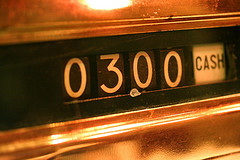
Is determining the best price a problem? Photo by luz from flickr.
Are you having trouble determining how to set the best price for your products or services? That seems to be a common problem for owners of independent businesses.
Do it right and customers will be content, happy to pay you what you deserve, and you’ll be around. Do it wrong and you won’t. It’s that simple.
The best pricing system takes these 8 items into consideration:
- True total costs
- Profit
- Contingency
- Overhead
- Payback for investment
- Positioning
- Value
- Time
You may think you know what each of these mean. See if you do and if you agree with me.
Does Your Best Price Include Your True Total Costs?
These are all the costs that you have spent or will spend on getting ready to offer this particular product or service. Seems easy. But it’s easy to think you’ve only spend $10K and discover it’s closer to $60K. Especially if you’re used to throwing receipts in an old shoe box.
The easy costs to account for are research and development. But we’re also talking about vision and planning costs, preparation, training, pre-launch marketing expenses, legal, administrative help and the costs to find the right people, insurance, etc. There’s also a part of overhead that was and is used for getting this product or service out the door that is part of the true total costs.
Your list of true total costs will probably be longer and larger than you thought. Make sure you don’t miss anything.
What’s the Right Profit Level?
Too little profit and it can be hardly worth doing except maybe for credentials or experience. Too much and it can seem like gouging. Owners become so concerned about being “fair” that they forget what profit is used for. It’s is what you use to keep up your quality and grow. You’ve gotta have it.
You can punt and see what the “industry standard” is or what competitors are doing. Neither of these may be right or reflect your situation but they are a good place to start or finish. It’s one of the hardest things to determine.
What’s the Right Contingency Amount to Include?
What is it about contingency? You’re never going to make a mistake and have to redo something, right? Those are just a few big reasons to have a contingency amount also built in to your pricing. That amount is usually based on your historical experience with this product or service or these type of clients. And, yes, you can legally charge different clients different amounts. Just be careful and research this area first.
You Know about Overhead; So, Include It
Who pays for your overhead? Your customer needs to pay their share so you can keep providing them what they need and want. You should know what it costs to run the business on a monthly/yearly basis. You should include a portion of it in every sale.
How much? That depends on how many sales you plan for. We had a laboratory and testing client that only had six potential customers worldwide. Not many customers but a lot of sales per customer. The overhead amount was based on those two facts.
Your Price Needs to Pay You for Your Investment
One of the reasons owners under-value and under-price is that they discount the risk they took in starting this business and offering these products and services. Your price should include some amount that accounts for the risk you took and the ongoing risk you take.
Price for Now and the Future Based on Positioning and the Value You Provide
Low ball your price now and you can’t pay for anything later and you probably won’t be around.
Pricing for positioning means deciding what you want customers to think of you: discount? low-priced? average? high-priced/luxury/high quality? Use that image to arrive at a final best price.
The same is true of value. What value do you bring that no other product or service can? This is your uniqueness. It also goes into setting the best price.
Is Time Missing from Your Pricing?
Research, planning, implementing, evaluating and upgrading all take time and that costs your business. Don’t leave out these for your employees or for YOU! We see this way to often.
Add these Up to Get Your Best Price
All that’s left is to add these up to arrive at the best price and the right price. Once you do, remember to review your pricing at least quarterly. It’s not set in concrete although you do want it to be consistent over time. Things change. Don’t get caught with 1990’s pricing unless you’re doing that purposefully and can afford it.
What you want is “Pricing Power”!
One definition for this term is the effect that a change in a firm’s product price has on the quantity demanded for that product. Pricing power also ties in with the “Price Elasticity of Demand.” Without this power, you really can’t increase your prices so be sure to focus on the benefits your company and products and service provide that are valuable to your Platinum Profile Customers™.
Also check out my post on Legacy Pricing™.
What’s your pricing system based on? Do you feel you arrived at the best price for your company and your customers?






Leave a Reply
You must be logged in to post a comment.